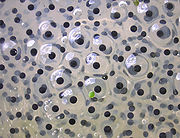
Anamniotes
Encyclopedia
The anamniotes are an informal group of vertebrates that lack the amnion
during fetal development. These animals are not able to have embryo
s that develop on land, thus they lay their egg
s in water exclusively. During their embryonic development, all anamniote classes
pass through a stage which resembles fish, thus indicating their close physiological
relationship.
 The anamniotes comprises the fishes and the amphibians, the "lower vertebrates", as opposed to the amniotes, the "highter vertebrates". The group is characterized by retaining the primitive vertebrate condition in several traits:
The anamniotes comprises the fishes and the amphibians, the "lower vertebrates", as opposed to the amniotes, the "highter vertebrates". The group is characterized by retaining the primitive vertebrate condition in several traits:
classification just below the level of Vertebrata, though Huxley presented the Ichtyopsida as an informal unit and never ventured to forward a Linnaean rank
for the group. The term ichthyopsida means fish-face or fish-like as opposed to the sauropsida
or lizard-face animals (reptiles and birds) and the mammals.
The group representing an evolutionary grade
rather than a clade
, the term anamniote is now used as an informal way of denoting the physical property of the group, rather than as a systematic unit.
Amnion
The amnion is a membrane building the amniotic sac that surrounds and protects an embryo. It is developed in reptiles, birds, and mammals, which are hence called “Amniota”; but not in amphibians and fish , which are consequently termed “Anamniota”. The primary role of this is the protection of the...
during fetal development. These animals are not able to have embryo
Embryo
An embryo is a multicellular diploid eukaryote in its earliest stage of development, from the time of first cell division until birth, hatching, or germination...
s that develop on land, thus they lay their egg
Egg (biology)
An egg is an organic vessel in which an embryo first begins to develop. In most birds, reptiles, insects, molluscs, fish, and monotremes, an egg is the zygote, resulting from fertilization of the ovum, which is expelled from the body and permitted to develop outside the body until the developing...
s in water exclusively. During their embryonic development, all anamniote classes
Class (biology)
In biological classification, class is* a taxonomic rank. Other well-known ranks are life, domain, kingdom, phylum, order, family, genus, and species, with class fitting between phylum and order...
pass through a stage which resembles fish, thus indicating their close physiological
Physiology
Physiology is the science of the function of living systems. This includes how organisms, organ systems, organs, cells, and bio-molecules carry out the chemical or physical functions that exist in a living system. The highest honor awarded in physiology is the Nobel Prize in Physiology or...
relationship.
Anamniote traits

- Presence at some period of life of gills
- Absence of an amnionAmnionThe amnion is a membrane building the amniotic sac that surrounds and protects an embryo. It is developed in reptiles, birds, and mammals, which are hence called “Amniota”; but not in amphibians and fish , which are consequently termed “Anamniota”. The primary role of this is the protection of the...
- Absence or rudimentary condition of the allantoisAllantoisAllantois is a part of a developing animal conceptus . It helps the embryo exchange gases and handle liquid waste....
- Nucleated red blood cells.
History of discovery
The features unifying the anamniotes was first noted by Thomas Henry Huxley in 1863, who coined the phrase Ichtioid or Ichthyopsida ("fish-face") for the group. It is a taxonomicAlpha taxonomy
Alpha taxonomy is the discipline concerned with finding, describing and naming species of living or fossil organisms. This field is supported by institutions holding collections of these organisms, with relevant data, carefully curated: such institutes include natural history museums, herbaria and...
classification just below the level of Vertebrata, though Huxley presented the Ichtyopsida as an informal unit and never ventured to forward a Linnaean rank
Linnaean taxonomy
Linnaean taxonomy can mean either of two related concepts:# the particular form of biological classification set up by Carl Linnaeus, as set forth in his Systema Naturæ and subsequent works...
for the group. The term ichthyopsida means fish-face or fish-like as opposed to the sauropsida
Sauropsida
Sauropsida is a group of amniotes that includes all existing reptiles and birds and their fossil ancestors, including the dinosaurs, the immediate ancestors of birds...
or lizard-face animals (reptiles and birds) and the mammals.
The group representing an evolutionary grade
Evolutionary grade
In alpha taxonomy, a grade refers to a taxon united by a level of morphological or physiological complexity. The term was coined by British biologist Julian Huxley, to contrast with clade, a strictly phylogenetic unit.-Definition:...
rather than a clade
Clade
A clade is a group consisting of a species and all its descendants. In the terms of biological systematics, a clade is a single "branch" on the "tree of life". The idea that such a "natural group" of organisms should be grouped together and given a taxonomic name is central to biological...
, the term anamniote is now used as an informal way of denoting the physical property of the group, rather than as a systematic unit.

